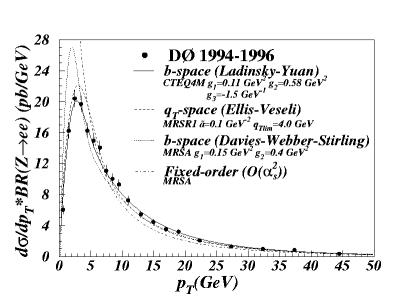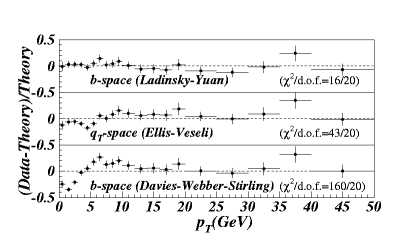
Publications and Documents:

Transverse Momentum of the Z Boson |

|
Publications and Documents: |

|
Web pages related to the analysis: |
Making a Z boson
The Z boson is the neutral carrier of the weak force (the
W+ and W- are the other two, charged, carriers). The DØ
experiment is located at a proton-antiproton collider called the
Tevatron. In proton-antiproton collisions, Z bosons are sometimes
created when a quark from the proton collides with an antiquark from
the antiproton. Transverse momentum is momentum (motion) perpendicular
to the colliding beams. Because momentum is conserved, we know that
if the quarks always collided head-on, the Z
boson created would never have any transverse momentum. The fact that
the Z boson can have lots of transverse momentum means that the
quarks do not collide head-on, but bang into one another at some angle.
Measuring the transverse momentum of
the Z, therefore, tells us something about how quarks move around
inside protons and antiprotons -- tells us something about the
structure matter.
Seeing a Z boson
In an experiment we don't actually observe the Z boson itself
because it decays too quickly -- it doesn't even travel as far as one
atom! However, it does decay into electrons, muons, and quarks, which
don't decay and are easy to observe in a detector like DØ. Most
often, the Z
decays to quarks, which are observed in the detector as a spray of
particles called a jet. However, it is very difficult to observe Z
boson decays into two jets if the Z is produced by colliding quarks
(i.e., at a proton-antiproton collider) because the
most commonly occuring process when colliding quarks is "dijet" production
-- two quarks colliding with two quarks coming out. The probability of a
Z boson being produced when two quarks collide is many 1000 times less
than that of two quarks being produced.
In the end, the rate for dijets is so high that one simply cannot
tell the difference between two jets that came from a Z decay and two jets
that came from two colliding quarks. I chose to study the "electron
channel", where the Z boson decays into an electron and a positron,
because electrons are the most precisely measured objects at DØ
and would, therefore, yield the most precisely measured Z bosons.
More to come.
| © Copyright 2001 by Dylan Casey. All Rights Reserved. |